Lingyun Chen
Elliptical K-Nearest Neighbors -- Path Optimization via Coulomb's Law and Invalid Vertices in C-space Obstacles
Aug 27, 2025Abstract:Path planning has long been an important and active research area in robotics. To address challenges in high-dimensional motion planning, this study introduces the Force Direction Informed Trees (FDIT*), a sampling-based planner designed to enhance speed and cost-effectiveness in pathfinding. FDIT* builds upon the state-of-the-art informed sampling planner, the Effort Informed Trees (EIT*), by capitalizing on often-overlooked information in invalid vertices. It incorporates principles of physical force, particularly Coulomb's law. This approach proposes the elliptical $k$-nearest neighbors search method, enabling fast convergence navigation and avoiding high solution cost or infeasible paths by exploring more problem-specific search-worthy areas. It demonstrates benefits in search efficiency and cost reduction, particularly in confined, high-dimensional environments. It can be viewed as an extension of nearest neighbors search techniques. Fusing invalid vertex data with physical dynamics facilitates force-direction-based search regions, resulting in an improved convergence rate to the optimum. FDIT* outperforms existing single-query, sampling-based planners on the tested problems in R^4 to R^16 and has been demonstrated on a real-world mobile manipulation task.
Learning Task Planning from Multi-Modal Demonstration for Multi-Stage Contact-Rich Manipulation
Sep 18, 2024



Abstract:Large Language Models (LLMs) have gained popularity in task planning for long-horizon manipulation tasks. To enhance the validity of LLM-generated plans, visual demonstrations and online videos have been widely employed to guide the planning process. However, for manipulation tasks involving subtle movements but rich contact interactions, visual perception alone may be insufficient for the LLM to fully interpret the demonstration. Additionally, visual data provides limited information on force-related parameters and conditions, which are crucial for effective execution on real robots. In this paper, we introduce an in-context learning framework that incorporates tactile and force-torque information from human demonstrations to enhance LLMs' ability to generate plans for new task scenarios. We propose a bootstrapped reasoning pipeline that sequentially integrates each modality into a comprehensive task plan. This task plan is then used as a reference for planning in new task configurations. Real-world experiments on two different sequential manipulation tasks demonstrate the effectiveness of our framework in improving LLMs' understanding of multi-modal demonstrations and enhancing the overall planning performance.
TacDiffusion: Force-domain Diffusion Policy for Precise Tactile Manipulation
Sep 17, 2024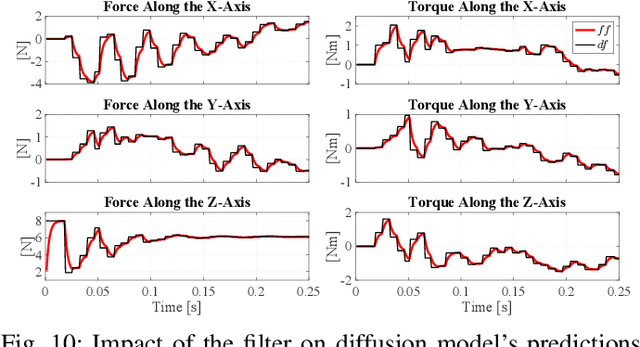
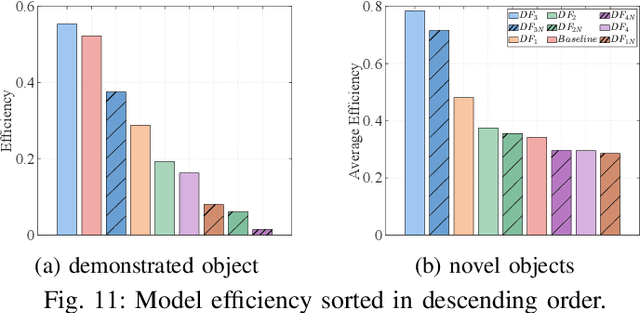
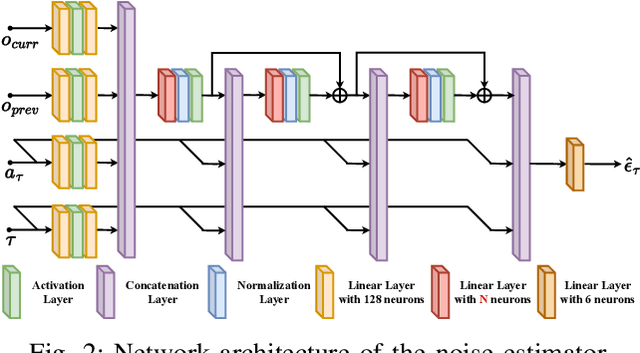
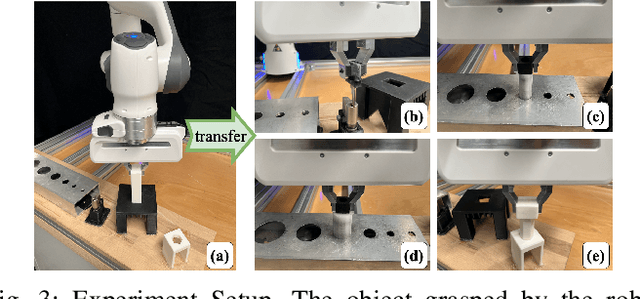
Abstract:Assembly is a crucial skill for robots in both modern manufacturing and service robotics. However, mastering transferable insertion skills that can handle a variety of high-precision assembly tasks remains a significant challenge. This paper presents a novel framework that utilizes diffusion models to generate 6D wrench for high-precision tactile robotic insertion tasks. It learns from demonstrations performed on a single task and achieves a zero-shot transfer success rate of 95.7% across various novel high-precision tasks. Our method effectively inherits the self-adaptability demonstrated by our previous work. In this framework, we address the frequency misalignment between the diffusion policy and the real-time control loop with a dynamic system-based filter, significantly improving the task success rate by 9.15%. Furthermore, we provide a practical guideline regarding the trade-off between diffusion models' inference ability and speed.
Time-Optimized Trajectory Planning for Non-Prehensile Object Transportation in 3D
Aug 29, 2024Abstract:Non-prehensile object transportation offers a way to enhance robotic performance in object manipulation tasks, especially with unstable objects. Effective trajectory planning requires simultaneous consideration of robot motion constraints and object stability. Here, we introduce a physical model for object stability and propose a novel trajectory planning approach for non-prehensile transportation along arbitrary straight lines in 3D space. Validation with a 7-DoF Franka Panda robot confirms improved transportation speed via tray rotation integration while ensuring object stability and robot motion constraints.
Identification and validation of the dynamic model of a tendon-driven anthropomorphic finger
Aug 23, 2024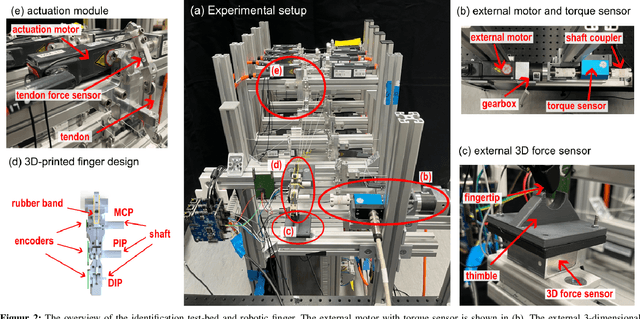

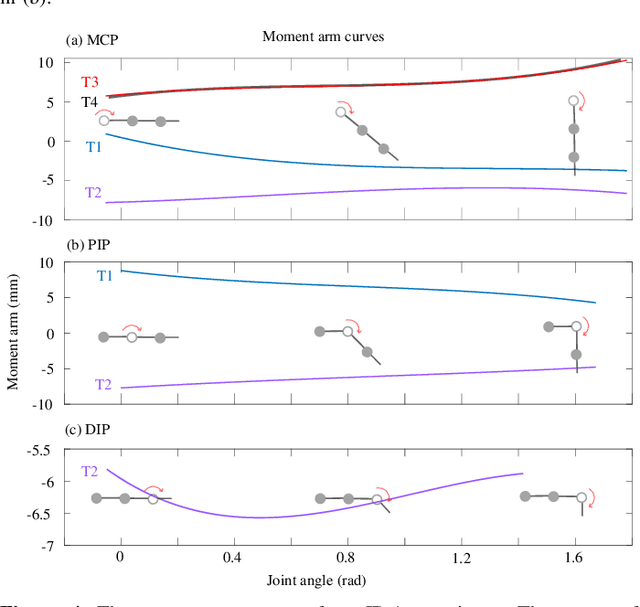
Abstract:This study addresses the absence of an identification framework to quantify a comprehensive dynamic model of human and anthropomorphic tendon-driven fingers, which is necessary to investigate the physiological properties of human fingers and improve the control of robotic hands. First, a generalized dynamic model was formulated, which takes into account the inherent properties of such a mechanical system. This includes rigid-body dynamics, coupling matrix, joint viscoelasticity, and tendon friction. Then, we propose a methodology comprising a series of experiments, for step-wise identification and validation of this dynamic model. Moreover, an experimental setup was designed and constructed that features actuation modules and peripheral sensors to facilitate the identification process. To verify the proposed methodology, a 3D-printed robotic finger based on the index finger design of the Dexmart hand was developed, and the proposed experiments were executed to identify and validate its dynamic model. This study could be extended to explore the identification of cadaver hands, aiming for a consistent dataset from a single cadaver specimen to improve the development of musculoskeletal hand models.
OPENGRASP-LITE Version 1.0: A Tactile Artificial Hand with a Compliant Linkage Mechanism
Aug 05, 2024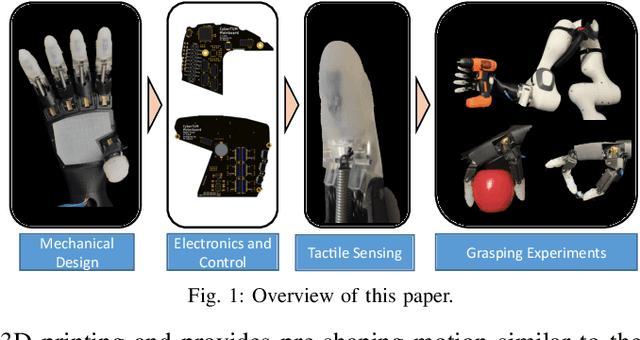
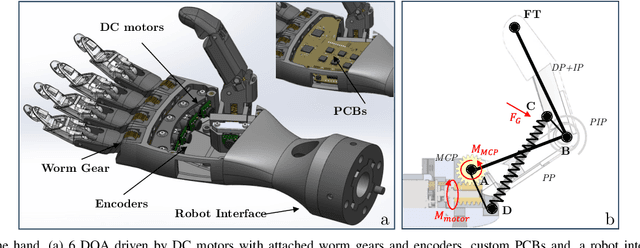


Abstract:Recent research has seen notable progress in the development of linkage-based artificial hands. While previous designs have focused on adaptive grasping, dexterity and biomimetic artificial skin, only a few systems have proposed a lightweight, accessible solution integrating tactile sensing with a compliant linkage-based mechanism. This paper introduces OPENGRASP LITE, an open-source, highly integrated, tactile, and lightweight artificial hand. Leveraging compliant linkage systems and MEMS barometer-based tactile sensing, it offers versatile grasping capabilities with six degrees of actuation. By providing tactile sensors and enabling soft grasping, it serves as an accessible platform for further research in tactile artificial hands.
Autonomous and Teleoperation Control of a Drawing Robot Avatar
Jul 29, 2024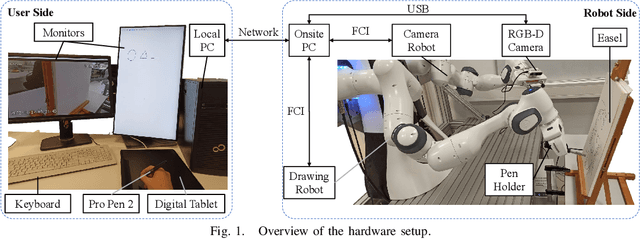

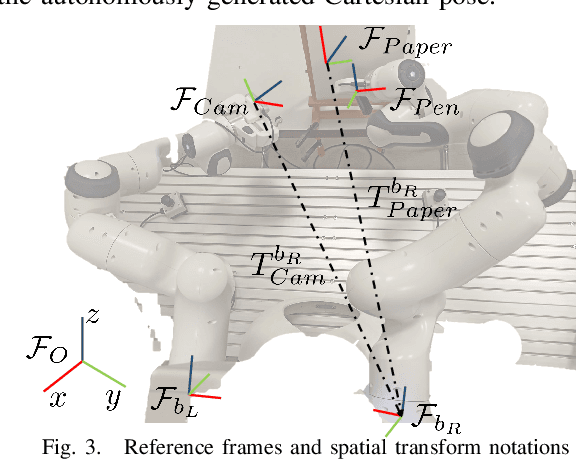
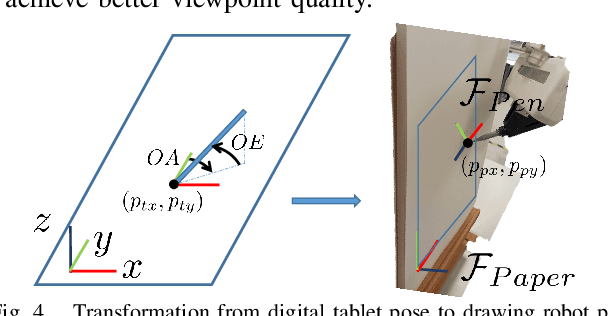
Abstract:A drawing robot avatar is a robotic system that allows for telepresence-based drawing, enabling users to remotely control a robotic arm and create drawings in real-time from a remote location. The proposed control framework aims to improve bimanual robot telepresence quality by reducing the user workload and required prior knowledge through the automation of secondary or auxiliary tasks. The introduced novel method calculates the near-optimal Cartesian end-effector pose in terms of visual feedback quality for the attached eye-to-hand camera with motion constraints in consideration. The effectiveness is demonstrated by conducting user studies of drawing reference shapes using the implemented robot avatar compared to stationary and teleoperated camera pose conditions. Our results demonstrate that the proposed control framework offers improved visual feedback quality and drawing performance.
Learning Barrier-Certified Polynomial Dynamical Systems for Obstacle Avoidance with Robots
Mar 13, 2024Abstract:Established techniques that enable robots to learn from demonstrations are based on learning a stable dynamical system (DS). To increase the robots' resilience to perturbations during tasks that involve static obstacle avoidance, we propose incorporating barrier certificates into an optimization problem to learn a stable and barrier-certified DS. Such optimization problem can be very complex or extremely conservative when the traditional linear parameter-varying formulation is used. Thus, different from previous approaches in the literature, we propose to use polynomial representations for DSs, which yields an optimization problem that can be tackled by sum-of-squares techniques. Finally, our approach can handle obstacle shapes that fall outside the scope of assumptions typically found in the literature concerning obstacle avoidance within the DS learning framework. Supplementary material can be found at the project webpage: https://martinschonger.github.io/abc-ds
Flexible Informed Trees (FIT*): Adaptive Batch-Size Approach for Informed Sampling-Based Planner
Oct 19, 2023



Abstract:In modern approaches to path planning and robot motion planning, anytime almost-surely asymptotically optimal planners dominate the benchmark of sample-based planners. A notable example is Batch Informed Trees (BIT*), where planners iteratively determine paths to groups of vertices within the exploration area. However, maintaining a consistent batch size is crucial for initial pathfinding and optimal performance, relying on effective task allocation. This paper introduces Flexible Informed Tree (FIT*), a novel planner integrating an adaptive batch-size method to enhance task scheduling in various environments. FIT* employs a flexible approach in adjusting batch sizes dynamically based on the inherent complexity of the planning domain and the current n-dimensional hyperellipsoid of the system. By constantly optimizing batch sizes, FIT* achieves improved computational efficiency and scalability while maintaining solution quality. This adaptive batch-size method significantly enhances the planner's ability to handle diverse and evolving problem domains. FIT* outperforms existing single-query, sampling-based planners on the tested problems in R^2 to R^8, and was demonstrated in real-world environments with KI-Fabrik/DARKO-Project Europe.
Towards Task-Specific Modular Gripper Fingers: Automatic Production of Fingertip Mechanics
Oct 18, 2022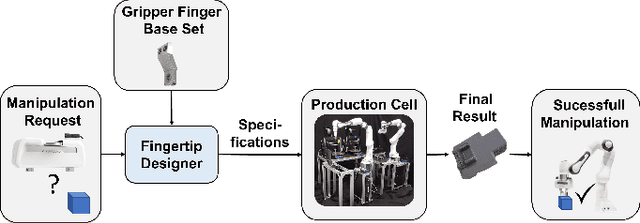
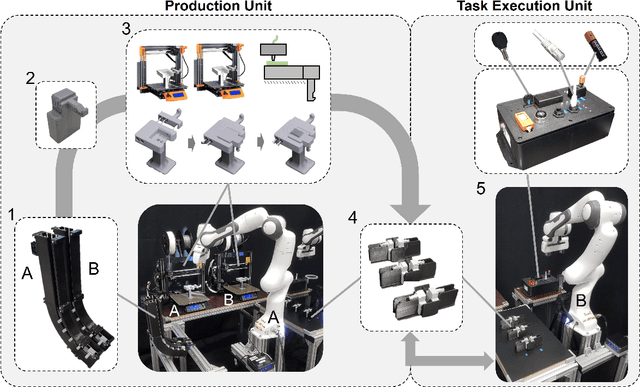
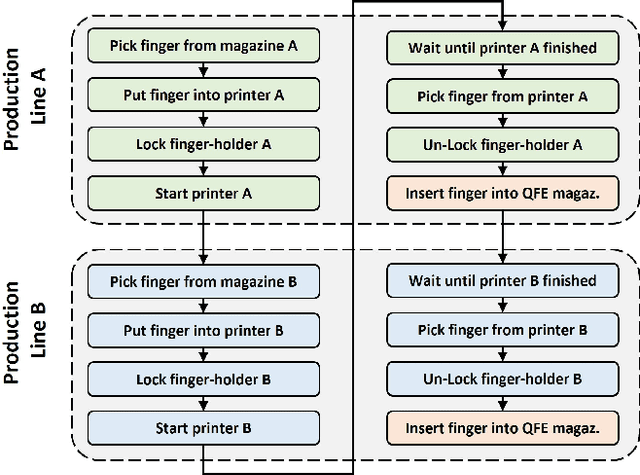
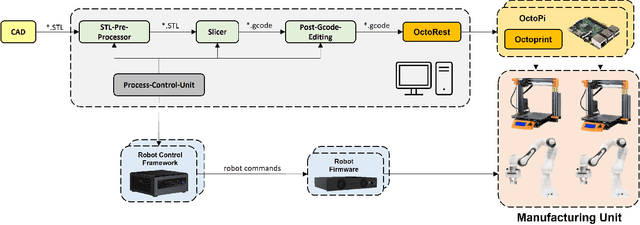
Abstract:The number of sequential tasks a single gripper can perform is significantly limited by its design. In many cases, changing the gripper fingers is required to successfully conduct multiple consecutive tasks. For this reason, several robotic tool change systems have been introduced that allow an automatic changing of the entire end-effector. However, many situations require only the modification or the change of the fingertip, making the exchange of the entire gripper uneconomic. In this paper, we introduce a paradigm for automatic task-specific fingertip production. The setup used in the proposed framework consists of a production and task execution unit, containing a robotic manipulator, and two 3D printers - autonomously producing the gripper fingers. It also consists of a second manipulator that uses a quick-exchange mechanism to pick up the printed fingertips and evaluates gripping performance. The setup is experimentally validated by conducting automatic production of three different fingertips and executing graspstability tests as well as multiple pick- and insertion tasks, with and without position offsets - using these fingertips. The proposed paradigm, indeed, goes beyond fingertip production and serves as a foundation for a fully automatic fingertip design, production and application pipeline - potentially improving manufacturing flexibility and representing a new production paradigm: tactile 3D manufacturing.
 Add to Chrome
Add to Chrome Add to Firefox
Add to Firefox Add to Edge
Add to Edge